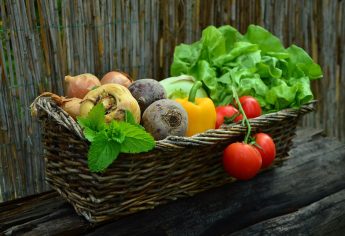When you are going grocery shopping, and you want to make a robust salad with a variety of vegetables which may include broccoli, lettuce, tomatoes, eggplant, cucumber, endive, mushrooms, and so on, you probably don’t consider that those vegetables that you use for your salad come from different categories.
All you know is that you are looking to make yourself a healthy salad with plenty of fiber and other nutrients to optimize your health. The only thing you may think about right away when it comes to classifying vegetables is that tomatoes and cucumbers are technically fruits, not vegetables. However, what you see in the produce section goes much deeper than that.
That is because all vegetables are not classified into one type, as there are four different types. The four different types of vegetables are greens, roots, cruciferous, and nightshades.
What Are The Four Main Types Of Vegetables?
Let’s go over each type further in detail right now.
Root Vegetables
Root vegetables are the plant parts that humans and other animals eat grown underground. You can call root vegetables storage organs as they maintain energy or carbohydrates in the main organ which is the vegetable. Some root vegetables are starchy, and others are not, but they all have a higher concentration of carbohydrates than many other vegetables.
What are the types of root vegetables?
Many types of root vegetables include carrots, parsnips, beets, radishes, Jerusalem artichoke, yams, potatoes, sweet potatoes, and rutabaga, to name a few.
What is the best time to grow vegetables?
The best time to grow root vegetables is during the fall, which is the peak season, and you can also grow them in the spring. The only root vegetable that does not do well in the fall are beets, and they grow best during the winter.
If you plan to grow root vegetables, that is essential to know, that they grow the best in loose and well-drained soil.
Even though root vegetables are higher in carbohydrates than other vegetables, people who have diabetes should still include them in their diets – in moderation. This is because they are still quite high in fiber and other essential nutrients, and fiber keeps you full and helps regulate your blood sugar as a result.
The next classification of vegetables is greens.
Greens
You likely hear a lot of buzz around greens because of their healthy characteristics. However, greens indeed are one of the most beneficial vegetables because not only are they full of fiber, but they contain so many essential nutrients and minerals that help you stay healthy. Therefore, greens are also known as leafy greens.
Examples of greens are
- kale
- collards
- spinach
- cabbage
- watercress
- Romaine lettuce
- Swiss Chard
- arugula
- endive
- bok choy
- lettuce
You may have also tried turnip greens or beet greens which are the leaves grown on the beet or turnip plants.
Why should greens be a part of the diet?
Greens should be in the diet of anyone because they are also full of antioxidants that help with tissue repair and calcium and folate. In addition, professionals advise pregnant women to eat plenty of greens because folate is essential for the development of the fetus to help prevent certain defects.
Some greens are also cruciferous vegetables such as bok choy, cabbage, and kale.
Cruciferous Vegetables
Cruciferous vegetables belong to the group Brassicaceae and have plenty of similarities to greens. Some cruciferous are in the greens category and contain similar amounts of vitamins, minerals, fiber, and antioxidants essential for your health and wellbeing.
These vegetables are high in Vitamin C and phytochemicals, and soluble fiber has so many health and immune-boosting benefits. The only reason that there is a difference in these vegetables is that not all greens come from the Brassicaceae group, and cruciferous vegetables form a shape of a cross with their flowers, hence the name which means cross-bearing.
The list of cruciferous vegetables include
- cauliflower
- broccoli
- Brussels sprouts
- kale
- cabbage
- bok choy
- horseradish
- collards
- kohlrabi
- rapini
- mustard seeds
- wasabi
However, these vegetables have properties that can interfere with thyroid function. That is why those who have an underactive thyroid or hypothyroidism should not eat cruciferous vegetables. If you suspect that you have a thyroid condition, you will want to talk to your doctor. If you do, then you will want to consult with a dietician.
Nightshades
The last classification of vegetables is nightshades, including
- eggplants
- tomatoes
- potatoes
- sweet potatoes
- bell peppers
- chili peppers
- paprika
- tomatillos.
Even though nightshades contain plenty of essential nutrients, there is a lot of talk about how people with specific food sensitivities and those who have conditions such as arthritis or other inflammatory conditions should keep away from them. That is because nightshades contain an alkaloid known as solanine, and in high concentrations, that can be toxic.
That is the reason that many nightshade plants are not edible. However, in edible nightshades, there are small amounts of solanine in them. There is a belief that the solanine in these nightshades can aggravate those who have food sensitivities and those who have inflammatory conditions.
More research needs to be conducted to verify how detrimental nightshades are for those who have those conditions. Some reports show that they can have some form of adverse effect, especially in those who have irritable bowel syndrome.
Learn more about vegetables and their types, HERE.
Conclusion
Now you see that different vegetables go beyond separating the fruits disguised as vegetables from legitimate vegetables. However, vegetables that fall into the same group have the same things in common with the others.
So even though all vegetables have plenty of essential nutrients and fiber, they also differ if they are in other classifications. That is why all root vegetables are higher in carbohydrates than greens, cruciferous vegetables, and nightshades.
That is also why greens are richer in minerals such as folate than many of the other vegetables. However, that is also why those with low thyroid function should not eat cruciferous vegetables but can eat others.
Finally, that is why those who have food sensitivities and inflammatory disorders may want to keep away from nightshades rather than the other types of vegetables. Not all vegetables are the same, even though they all have similarities to one another.
Which type of vegetable do you like the most, let us know in the comments below. Check out our website for more content like this.


